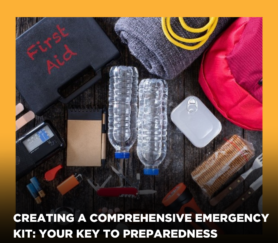National Preparedness Month Vol. 3: Developing a Family Evacuation Plan: Navigating Safety Together
- By: National Network of Public Health Institutes and Jennifer Ventura
- Date
In a world where unexpected events can disrupt our routines, having a well-thought-out family evacuation plan is an essential aspect of preparedness. Whether it’s a natural disaster, sudden emergency, or unforeseen crisis, having a clear plan in place ensures the safety and well-being of your loved ones. We will learn how the Department of Homeland Security prepares families on how to respond during an environmental emergency. As we observe Environmental Preparedness Month this September, let’s dive deep into the importance of developing a family evacuation plan and how to go about creating one.
The Significance of a Family Evacuation Plan
A family evacuation plan outlines a set of procedures to follow when you need to leave your home quickly and safely. This plan is crucial for various situations, from fires and floods to earthquakes and other emergencies. Having a plan in place minimizes panic, streamlines actions, and increases the likelihood of a successful evacuation.
Steps to Develop a Family Evacuation Plan
- Identify Exit Routes: Determine the best and safest ways to exit your home in various scenarios. Designate primary and secondary routes and make sure all family members are familiar with them. Ensure to be mindful of children, elders, and those who have disabilities, to be sure everyone can successfully exit your home, regardless of the circumstance put in place.
- Choose Meeting Points: Select multiple meeting points both near your home and farther away. Ensure these points are easily recognizable landmarks where everyone can regroup if separated.
- Communication Strategy: Establish a communication plan in case family members are not together during an emergency. Designate an out-of-town contact who can act as a central point for information.
- Account for Pets: If you have pets, include them in your plan. Be sure to identify pet-friendly shelters or friends’ homes where they can stay during an evacuation.
- Emergency Contacts: Compile a list of important contacts, including family members, neighbors, doctors, and emergency services. Keep this list accessible, up to date, and be sure everyone in your home is also aware of this list.
- Practice Drills: Regularly conduct evacuation drills with your family. Practice using different exit routes, meeting at designated points, and communicating with each other.
Customize the Plan
Every family is unique, so tailor your plan to suit your circumstances. Consider the needs of children, elderly family members, and individuals with disabilities. Keep in mind any specific medical requirements or dietary restrictions.
- Stay Informed: Stay informed about potential hazards in your area. Understand the types of disasters that are more likely to occur and adjust your evacuation plan accordingly.
- Spread Awareness: Discuss the evacuation plan with all family members, no matter their age. Ensure everyone understands their roles and responsibilities during an evacuation.
As we commemorate Environmental Preparedness Month, take the time to create or revisit your family evacuation plan. By doing so, you’re taking a proactive step toward the safety and well-being of your loved ones. Remember, emergencies may be unpredictable, but your preparedness doesn’t have to be.
About the Author:
Jennifer Ventura is a Program Assistant on the Climate, Crisis, and Preparedness Portfolio at the National Network of Public Health Institutes (NNPHI). She received her bachelor’s degree in Public Health from George Mason University in 2021. With an interest in Public Health and working on a focus on environmental health, my passion lies in understanding the relationship between human well-being and the environment. Through academic pursuits and current work experiences, I’ve become interested in the critical role of promoting climate change awareness. Recognizing that a healthy environment is crucial for community health, I’m dedicated to advocating for policies and practices that foster sustainability and safeguard the planet for current and future generations.


 Subscribe To Our Communications
Subscribe To Our Communications